A voluminous knitted scarf is a great addition to a woman's or child's wardrobe.. This openwork light accessory, made with knitting needles, protects well from the sun. It also protects the scalp from sweating and overheating. From the description of the creation of such a multifunctional thing, it becomes clear that it is suitable for both winter and summer. Beginner needlewomen are offered easy patterns for knitting such products.
Openwork kerchief with knitting needles. Simple model
The finished product without border measures 93x186 cm.
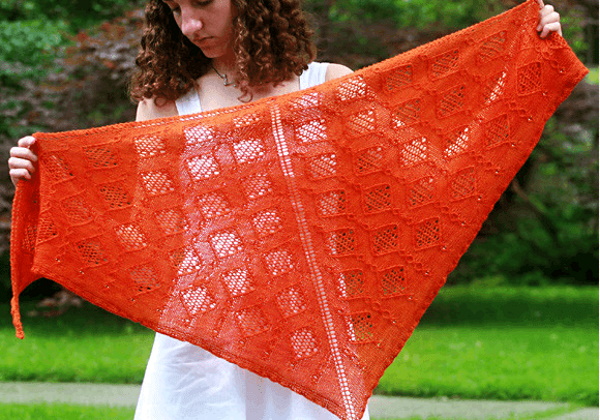
To create an openwork scarf, take:
- 125 g mohair yarn;
- straight knitting tools No. 3.5;
- knitting needles number 3.5 with fishing line;
- hook marked 3.
The openwork ornament is knitted according to the following pattern:
- in purl rows all yarn overs and loops must be purl;
- execution begins with 64 loops;
- even rows, from 4th to 6th, are made using purl elements;
- in 3 rows knit: edge, 4 front loops, yarn over, doubled extended loop and yarn over. All this is repeated 5 times;
- Then knit according to the pattern with diamonds:
- The last 12 rows are made with knit stitches.
The yarn for the openwork scarf should:
- be seasonal;
- suitable for different ages;
- be subtle.
An openwork kerchief with knitting needles (the diagram and description for such needlework are in sufficient quantity in the media) is knitted quickly and easily. It turns out original, and also looks interesting on the shoulders and head. It is usually made in the form of a solid triangular cloth or at an angle. The patterns of such products must be simple and understandable for beginner knitters.
An openwork kerchief turns out to be very light and warm if it is knitted with knitting needles using goat down yarn. Wool products turn out to be prickly, but durable. Beginner needlewomen are better off knitting kerchiefs with an openwork pattern from cotton threads. Such delicate accessories are especially suitable for cool summer evenings. Openwork kerchiefs are usually knitted by increasing or decreasing the number of loops.
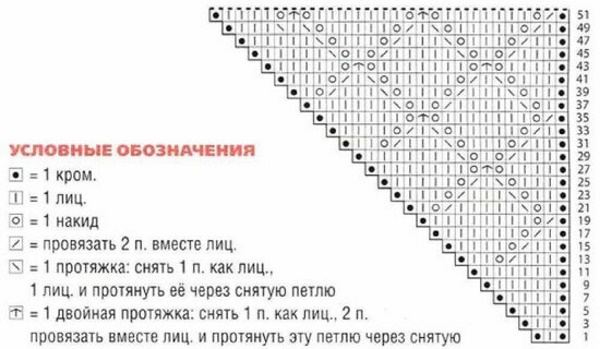
In the first method (addition), follow the further plan:
- After casting on 3 loops, in each subsequent row, at the beginning and end, add 1 element.
- With this knitting method, it is important to ensure that the corner of the product is formed correctly.
- The execution is finished when the required size of the headdress is reached. Then all the loops are closed.
When decreasing loops, do the following:
- First, a sample with a certain pattern is knitted. After that, the density of execution is calculated. Then the length of the side is determined. The obtained result is doubled and divided by the knitting density.
- Add 2 edge loops to the result of point 1.
- Next, the center of the product is marked with a marker. It is from this place that 3 elements are started together until the very end of knitting. The marking helps to make the edges fairly even.
- The decrease is also done by knitting the last 2 loops together. This is done until only 3 elements remain on the needles. These loops are also knitted together, and the remaining thread is secured.
An openwork kerchief with knitting needles (the diagram and description make it much easier to work on it) can be made using various methods. Shawl-shaped scarves made of wool are wear-resistant and have good thermal insulation. Such things are both decorative and functional.
Before the process of creating the product, the knitting needles are wiped with a soft material. This way the yarn will slide better on the knitting tools. The threads are rewound into balls before use. After all, there may be defects or breaks inside the fibers. The yarn in the ball will also never get tangled during the knitting process. It is recommended to place the skeins of thread in an empty container. This way the yarn will not get clogged or dirty.
With mandatory blocking of the created product, the openwork kerchief always turns out:
- air;
- with a clear pattern;
- with a strict form.
With a wide border
To create such a product with dimensions of 66x172 cm you will need:
- 300 g mixed yarn;
- circular knitting needles No. 5.5 with a 60 cm cord;
- hook No. 5;

- markers.
A 10x10 cm square should correspond to 16 loops and 24 rows of stocking stitch. This ratio determines the knitting density of the product with a wide border. The execution begins from the corner, having cast on 3 elements on the needles.
Then continue in the following order (indicated in the table below):
| Row numbers | Description of execution |
| 1st | Front, yarn over, marker, yarn over, front. |
| 2nd and 4th | Front, then purl along the edge loop, front. |
| 3rd | Front, addition, front, addition, deviation from limiter, addition, front, addition, front. |
An openwork kerchief with knitting needles (the diagram and description contain all the information about its creation) can be in the form of a shawl or scarf. Before starting any such work, the dimensions of the product and the density of its creation are determined. At the same time, rows and loops are also calculated, based on the thickness and type of yarn.
The mesh pattern is knitted according to the following principle:
- Front, yarn over addition, *2 together front, additional*, repeat pattern (contents in asterisks) to the last element before marking, front, yarn over, skip delimiter, front, ignore marking, additional, front, *add 1 loop, 2 together front* — repeat to edge, yarn over, front. This results in adding 4 elements.
- front, back to edge, front.
- The mesh pattern is repeated from stripes 1 to 2, 25 times. There are 56 elements on each side of the knitting (113 in total).
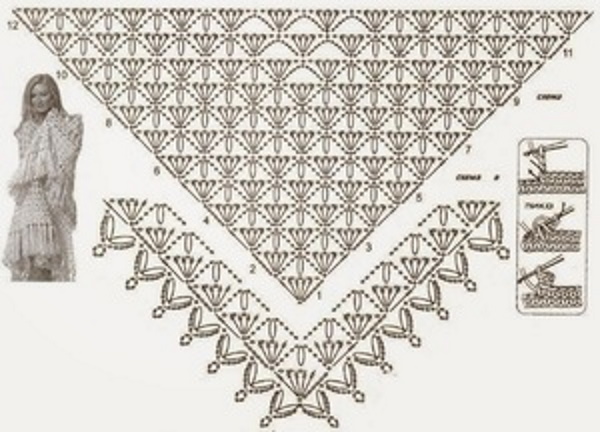
The middle border is knitted according to the following algorithm:
- Knit, yarn over, knits to last st before marker, yarn over, stopper, knit, remove marker, knit, remove stopper, knit, place marker, yarn over, knits along edge, yarn over, knit. This makes 117 stitches.
- Knit, yarn over, knits to 1 marker, which is skipped, 3 purl, skip marker, knits to edge, yarn over, knit. This makes 119 stitches.
- Knit, yarn over, knits to edge piece, yarn over, ignore marker, 3 knits, marker gap, yarn over, knits to edge piece, yarn over, knit. Total: 123 steps.
- Knit, yarn over, *2 steps purlwise, yarn over*, repeat pattern to last element before marker, purl, skip marking, 3 purl, space, purl, *yarn over, 2 elements purlwise*, repeat pattern to edge, yarn over, knit. The output is 125 elements.
- Repeat point 3, forming 129 steps at the end.
- They duplicate 2 points, leaving 131 elements on the instruments.
- knit, yarn over, knits to marking, yarn over, ignore marker, knit, yarn over, knit, yarn over, knit, skip marker, yarn over, knit to edge step, yarn over, knit; there are now 137 stitches on the needles.
- Knit, yarn over, *2tog purlwise, yarn over*, repeat pattern to last st before marker, knit, drop marker, purl 5, space, knit, *yarn over, purl 2*, repeat pattern to end st, yarn over, knit; increase 2 sts at end.
- Knit, yarn over, knits to edge, yarn over, space, knit, yarn over, 3 knits, yarn over, knit, ignore edge, yarn over, knits to edge, yarn over, knit. This makes an increase in 6 steps.
- Knit, yarn over, knits to marker, space it out, 7 purl, ignore marking, knits to edge piece, yarn over, knit. Total added 2 steps.
- knit, yarn over, knits to the delimiter, yarn over, space, 2 knits, double draw through (1 element is pulled over, and the next 2 are knitted, the resulting step is pulled through the slipped one), 2 knits, space, yarn over, knits along the edge, yarn over, knit. This results in an increase of 2 elements.
- Then repeat points 8 through 11 3 times. There should be 187 loops left on the tools.
- Knit, yarn over, purl to marker, set marker, 7 purl, remove marker and set marker again, purl to edge, yarn over, knit. There are 187 stitches left on the knitting jigs after this.
- Next, they begin knitting the lace border, the patterns and descriptions of which are available on Internet resources.
- The resulting 289 loops are closed with a hook from the front of the knitting.
Openwork kerchief "Leaves"
The finished shawl measures 70x138 cm.
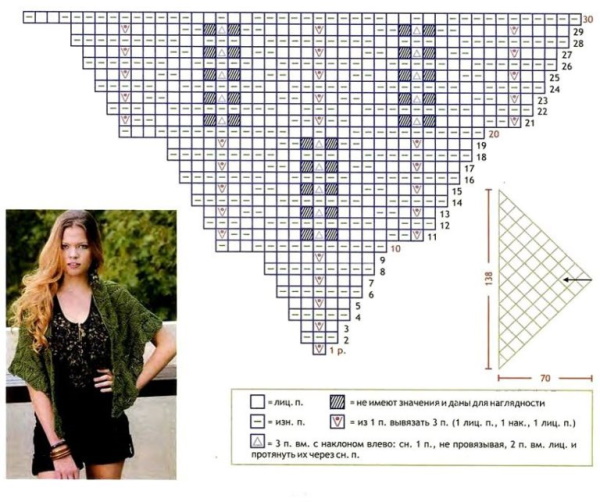
When working on a kerchief, the following materials and patterns are used:
- straight knitting needles No. 4, 5 and 6;
- 200 g semi-woolen yarn;
- elastic band 1x1;
- garter stitch;
- drawing Leaves according to the scheme:
The density of the product is determined by the ratio of a 10x10 cm square to 12 steps on 16 circles. On knitting tools No. 6, dial 1 element and perform the pattern from the image, complementing it with additional elements. With each circle, add 3 elements to the pattern motif. In the future, these steps continue to be performed according to the pattern of the scheme. After knitting 11 motifs, the loops are closed. Then, along the edges of the sides of the knitted kerchief, with knitting needles No. 4.5, pick up 150 loops.
Next, knit 1 row with a rib pattern. Then increase the number of loops, turning each even loop into 2. In this case, there should be 225 elements on the needles.
After the 2nd row, made with the front surface, switch to knitting needles No. 5. With these tools, knit 1 row with the front surface. Then continue with the Leaves pattern from the image of the execution technique from rows 21 to 30. This will correspond to 15 repetitions. From row 6, the kerchief is knitted with knitting needles No. 6. Having completed 30 rows, the loops are closed according to the pattern. The resulting border is carefully sewn to the kerchief.
Then the finished headdress with an openwork pattern is slightly moistened and horizontally straightened. Then the shawl is thoroughly dried. An openwork kerchief with knitting needles (the diagram and description depict in detail the entire process of its execution) turns out to be proportional and even if it is knitted strictly according to the proposed patterns. Such resources also allow craftswomen not to get confused while working.
Thick scarf with openwork
To create such a warm baktus, take:
- 2 skeins of semi-woolen threads;
- knitting needles with cord No. 3;
- hook No. 1.75 for tying the edges of the product.
The work is then carried out according to the following scheme:
- Cast on 195 stitches onto the knitting needles.
- In the front rows, together with the edge stitch, there should be 3 front loops.
- Next, knit a rapport (yarn over, 2 stitches together, 4 knit stitches), which is repeated to the end of the row.
- The outer loops are knitted purlwise or knitwise, depending on the pattern of the sides.
- Even rows and yarn overs are done with purl stitches.
- The elements are also reduced in even circles by knitting 2 loops together using the purl method.
- In the 3rd row, the rapport is performed as follows: yarn over, 2 together, knit, 2 together, knit. This repetition is duplicated to the end.
- The rapport in the 5th row should look like this: yarn over, 3 together, yarn over, 3 knits.
- The kerchief is knitted by duplicating rows 1-6 until there are 5 loops left on the needles. Of these: remove the 1st, knit the next 3 together as 1 purl, and make another 1 purl.
- Then the work is turned over and the last 3 loops are knitted together. The thread is then cut and hidden.
- If desired, the edges of the scarf can be crocheted.
Openwork shawls and baktuses serve perfectly at any time of the year and complement the image. Such kerchiefs are most in demand if they are created with knitting needles and from goat wool. After all, these accessories are not only warm, but also weightless. It will not be difficult for beginners to knit them at all if you use clear patterns and descriptions.
Openwork triangle shawl with pearl ornament
To knit a kerchief you will need:
- threads made of thin cotton or goat wool;
- thick knitting needles;
- approximate pattern diagram:
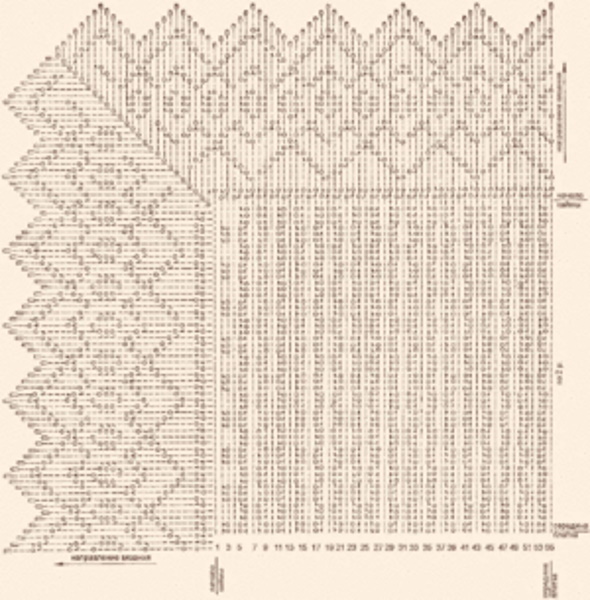
As you can see from the picture, its elements are often duplicated. First, knit the edge of the kerchief. To do this, cast on 21 loops on the knitting needles.
The first row should contain the following loops:
- 5 facial;
- 2 purl;
- 13 facial;
- stretching;
- 1 additional.
Due to the stretches in the rows, the edge comes out with a slight slope. According to the proposed scheme, the air pattern takes up half of the accessory.
To create a complete pattern, work on the product continues in a mirror direction. In even rows, loops are decreased.
When creating a kerchief using this method, use circular knitting needles No. 5.5 and 250 g of thread. 7 loops are cast on the knitting tools.
In the next row, after completing them, do:
- 2 knit, yarn over;
- repeat previous element;
- 2 facial.
In the 2nd row knit:
- 2 facial;
- 3 purl;
- 2 facial.
In odd rows, yarn overs are added, and in even lines, pairs of loops at the beginning and end of the circle are knitted as faces. In this way, 30 rows are knitted. The next circle after this is made with a pearl pattern.
For him, the following sequence follows until the end of the row:
- 2 facial;
- yarn over;
- 2 purl.
The next 10 rows are knitted as the 31st. From the 42nd line, make a leftward tilt. In this row, make a drawstring in the purl technique. The following circles, up to the 46th, are knitted with a pearl pattern. Rows 47-66 should be made with a garter stitch. From the 67th to the 78th circle, knit a pearl ornament.
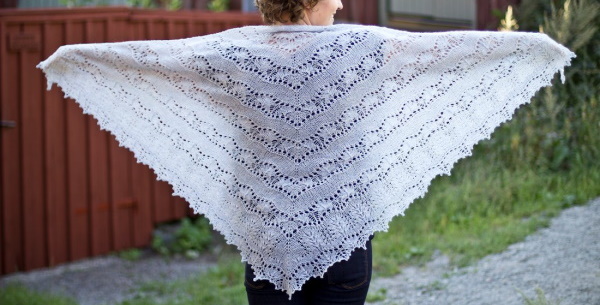
In row 79 do:
- 2 facial;
- yarn over;
- facial;
- yarn over;
- 2 knits to the left side;
- repeat previous actions to the center;
- duplication of the procedure in a mirror direction.
The next line should contain all the purl loops. This way the knitting is visually compacted. The next 6 rows are knitted with a pearl pattern. Circles 87-106 are made in the form of a garter stitch. The following lines, up to the 124th, are knitted with a stocking pattern. After this, the loops are closed and the end of the yarn is hidden.
Openwork scarf in romantic style
To knit such a scarf measuring 93x186 cm without a border, use:
- the density of work on openwork is 18 loops on 38 rows, which is equal to a square of 10x10 cm;
- 12-loop serrated pattern, worked according to diagram B:
- openwork ornament, which is knitted according to pattern A;
- 125 g mohair yarn;
- circular and straight knitting needles No. 3.5;
- hook marked 3.

Work on the product begins from the corner. 7 loops are cast on with straight knitting needles and an openwork pattern is knitted according to the diagram provided above. When the number of loops increases, straight knitting needles are replaced with circular ones. Having knitted 93 cm of fabric, the loops are closed.
Next, knit the scalloped canvas. To do this, cast on 12 loops. Then knit a row of front loops and 1 circle of back loops. The process continues according to diagram B. When the canvas reaches a length of 240 cm, close the loops. Then this finished element is sewn to the sides of the kerchief. The place of connection, on the back, is crocheted in the form of 1 circle of single crochets.
The next row is performed according to the pattern:
- 1 single crochet;
- *3 loops, single crochet in 1 loop, skip loop, single crochet*;
- repeat the rapport until the end of the circle.
Products in the form of knitted wool kerchiefs are relevant in any season. The description of their creation using knitting needles is understandable even for beginners. The patterns help needlewomen experiment with any threads. Openwork shawls created according to them serve their owners for a long time and give them the warmth of human hands.
Video on how to knit an openwork kerchief with knitting needles
Knitting a beautiful shawl with a star pattern:
